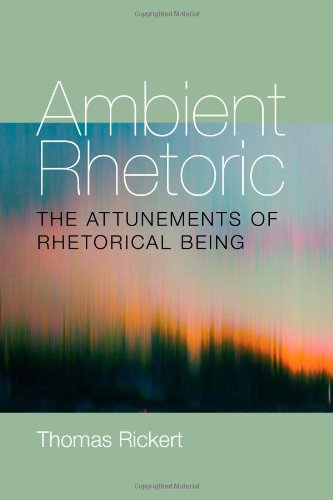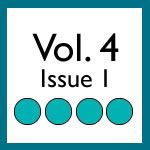Book Review: Rickert’s Ambient Rhetoric
Rickert, Thomas. Ambient Rhetoric: The Attunements of Rhetorical Being. Pittsburgh: University of Pittsburgh Press, 2013. Print.
 In his convincing—and hefty—Ambient Rhetoric: The Attunements of Rhetorical Being, Thomas Rickert theorizes rhetoric beyond its traditional subject-centered formulation. As often criticized during the past several decades, rhetoric—as a discipline, as a body of knowledge—has resisted the continuing challenges to all of its so-called foundational edges: the rhetor, the audience, the situation, the context, the message. Rickert’s Ambient Rhetoric attempts to retheorize rhetoric beyond the straight jacket of these foundational assumptions. Indeed, Rickert presses rhetoric beyond—not only the foundational constraints of subject, audience, context, etc.—but further beyond the assumption of rhetoric as a uniquely “human” activity.
In his convincing—and hefty—Ambient Rhetoric: The Attunements of Rhetorical Being, Thomas Rickert theorizes rhetoric beyond its traditional subject-centered formulation. As often criticized during the past several decades, rhetoric—as a discipline, as a body of knowledge—has resisted the continuing challenges to all of its so-called foundational edges: the rhetor, the audience, the situation, the context, the message. Rickert’s Ambient Rhetoric attempts to retheorize rhetoric beyond the straight jacket of these foundational assumptions. Indeed, Rickert presses rhetoric beyond—not only the foundational constraints of subject, audience, context, etc.—but further beyond the assumption of rhetoric as a uniquely “human” activity.
Contributing to a swelling surge of scholarship in rhetoric studies, Rickert’s text puts into conversation challenges to traditional rhetoric posed by object-oriented rhetorics (Brown; Barad); animal rhetorics (Davis; Hawhee); complexity theory (Hawk); and material and affect studies (Edbauer; Gross; Gunn). Such studies, for example, question the assumption, the easy assumption, that rhetoric is in Thomas Cole’s estimation “a speaker’s or writer’s self-conscious manipulation of his medium with a view to ensuring his message as favorable a reception as possible on the part of the particular audience being addressed” (qtd. in Rickert 35). Cole’s fairly traditional and standard definition is adopted as foundational in rhetoric studies—despite continuing pressure to it by rhetoric scholars trained in post-structuralist studies. Rickert, in contrast to Cole’s standard definition, retheorizes rhetoric as ambient—as persuasive, but as a persuasive process, context, or relation that is not reducible to a subject, to epistemology, to the human. Indeed, Rickert proffers a “definition” of rhetoric as a “responsive way of revealing the world for others, responding to and put forth through affective, symbolic, and material means, so as to (at least potentially) reattune or otherwise transform how others inhabit the world to an extent that calls for some action” (162; emphasis in original). Rickert, in effect, is inviting us to attune to a more primordial rhetorical state of being—prior to any subjectivity, any epistemology, any rhetor, as such. Although we welcome this invitation, we do struggle, however, with his oft-repeated claim that rhetoric is “ontological,” although we understand that he is using the term in an Heideggerian sense, which attempts to stretch the term beyond the perennial philosophy (being) vs. rhetoric (becoming) debate. His partnership with Heidegger, however, opens up its own set of problematics, and to his credit, Rickert addresses such problematics as Heidegger’s provincialism (with playful references to lyrics from the 1970s rock groups Foghat and War), his Luddism, and his Nazism. Rikert’s review of the fourfold’s rich philosophical ancestry is likewise notable for its demystification of Heidegger’s fourfold (229-32). But, more to the immediate point, Rickert is distancing himself from the clarion, hubristic call that rhetoric studies has embraced for many decades: rhetoric is epistemic. To claim such, Rickert rightly notes, is to continue with a subject-centered notion of rhetoric. For what else is epistemology than a study of the science of knowing, from a subject’s point of view? From a human subject’s point of view? Ambient Rhetoric succeeds because it usefully synthesizes and extends a broad range of anti-epistemological stirrings from within and outside of rhetoric studies and because it attempts to come to grips with some of the implications of an anti-epistemological shift. And in line with the attunement to ambience it advocates, it does so while at the same time acknowledging just how many important considerations remain our purview.
Rickert’s theorization of such an ambient rhetoric begins with his argument that the digital information age and the extensive networking resulting from it, along with postmodernism, have caused thinkers in a variety of fields (including but not limited to cognitive science, speculative realism, and extended mind theory) to consider ambience. He defines ambience as environment, but more specifically as environment that constitutes and is in turn constituted by the subjects situated within it. Recognizing ambience takes the form of attunement, a key concept that suggests “a fundamental entanglement, with the individuation of particular facets being an achieved disclosure. Thus, wakefulness to ambience is not a subjective achievement but rather an ambient occurrence: an attunement” (8). Taking as his starting point Heidegger’s claim that human and world are inseparable, Rickert presents attunement a way of being in the world that accounts for both salient and non-salient features of the world. Rhetoric, he argues, has traditionally emphasized the salient, but it should henceforth acknowledge the non-salient and in so doing become “one of the modalities for attunement to the world” (xviii).
Rickert’s argument unfolds in two sections: Part I, “Diffractions of Ambience,” and Part II, “Dwelling with Ambience.” Of particular note, in the first part, Rickert discusses and retheorizes vis a vis ambience two heretofore foundational rhetorical concepts: the chōra and kairos, effectually retheorizing time and space in an ambient mode.
In Chapter 1, “Toward the Chōra: Kristeva, Derrida, and Ulmer on Emplaced Invention,” Rickert examines theorizations of the chōra by Plato, Julia Kristeva, Jacques Derrida, and Gregory Ulmer. Though largely ignored by rhetoric (46), “The chōra illuminates how rhetoric and invention rest on an interplay of revealing and concealing, between, that is, a generative ‘infomaterial’ matrix difficult to apprehend but out of which we work for our rhetorical productions and within which they achieve their vibrancy” (43). The chōra, then, refers to the multifaceted place (or space) of invention. Invention becomes ambient in the sense that human agency, though important, is seen as but one of many elements contributing to the emergence of the rhetorical act.
Rickert’s Chapter 2, “Invention in the Wild: On Locating Kairos in Space-Time,” proceeds along similar lines; again Rickert takes a traditional concept—this time, kairos—and reconsiders it with ambience in mind. He traces the term to its Greek origins in order to (re)emphasize its material aspects (for instance, it refers in its earliest extant form in Homer’s Iliad to the spot to aim for when shooting the enemy with arrows, that is, to the “deadliest spot” [77]) and to show that timeliness isn’t all about the rhetor, but about the situation as well. Once again, invention needs to be rethought and becomes, to use a term Rickert employs often, emergent. This in turn necessitates a rethinking of what rhetoric is supposed to do: “Viewing kairos with the autonomous, willing subject replaced by an emplaced and dispersed subjectivity suggests kinds of invention attuned less to seeking advantage over or success against an audience than to working with what an audience and a material situation bring forth” (91). Rickert spends the remainder of the chapter reviewing anti-subjectivist contributions to thinking kairos from Mario Untersteiner, Bernard Miller, and Victor J. Vitanza.
In addition to retheorizing time and space, Rickert further problematizes both by situating them in a network, in the theorization of complexity. Chapter 3, “Ambient Work: Networks and Complexity in an Ambient Age,” forges connections between his concept of ambience and developments by Mark C. Taylor, among others, in complexity theory. This conversation, valuable for developing the notion of ambience, also highlights the shortcomings of complexity theory. Whereas network theory emphasizes “distribution, co-adaptation, and emergence,” ambience is posited as complexity theory plus the addition of “overall blended environment that the network does not offer” (106).
If Part I—“Diffractions of Ambience”—focuses primarily on locating ambience, then Part II—“Dwelling with Ambience”—focuses primarily on the implications of attending to ambience, of “thriving” through attunement (15). In Chapter 5, “Rhetoric, Language, Attunement: Burke and Heidegger,” Rickert considers language and rhetoric extended beyond the domain of the symbol and of meaning. He assumes a world that, though implicated in meaning and language, also exists outside of and beyond but is nevertheless constitutive of meaning. “We do not add meaning downstream,” he writes, “our experience is one where something is always already interpreted as something. In other words, what we do is always in the form of historically enculturated practices, most of which remain tacit, or ambient, in our everyday doings” (172; emphasis in original). Rickert finds formative considerations of this in the works of Burke and Heidegger. He concludes, however, that Burke ultimately fails to fully develop an ambient rhetoric. Burke is in his view a social constructionist when it comes to language: the world as we know it is necessarily mediated through language. This limits his proto-ambient thinking because it sets up and maintains a very verbal/non-verbal binary. Heidegger, meanwhile, breaks away from the notion that language is simply a series of signifiers to include “the background chorography, in its ‘thereness’ and its ‘manifestness,’ that orients, values, and prepares the sign for its embeddedness in human doing and knowing and thereby occasions its signing. It omits language’s constituent ambient dimension” (180).
The purpose of Chapter 6, “The Rhetorical Thing: Objective, Subjective, Ambient,” is to posit an ambient theory of materiality. As Rickert points out: “Rhetoric has always dealt with things” (191), by which he means that rhetoric has always dealt with materiality. But materialist rhetoric always unsatisfactorily resorts to some form of either realism or idealism, both of which reinforce the subject-object, human-nonhuman binary that the notion of ambience tries to breakdown. Put another way, both positions limit rhetoric to symbolic action. Rickert, however, wants to take rhetoric beyond the material as it’s mediated by the symbolic and toward the material as it “withdraws,” to use Heidegger’s term. Rhetoric, he writes, “[needs] a notion of materialism that includes meaning but declines to stop where meaning is understood to break off” (198). Again, Heidegger lays the groundwork, but Graham Harmon’s object-oriented ontology perhaps best orients us toward the “infinite array of perceptual, discursive, and material assemblages” that are nevertheless crucial for our comportment within the world (213).
It is in the penultimate chapter, “Attuning to Sufficiency: A Preparatory Study in Learning How to Dwell,” that Rickert is perhaps most straightforward about the implications of ambient rhetoric: “As the idea that our ambient environs participate in the work of suasion suggests, we need only attend to what is already manifest, to shift and broaden our emphasis” (261). This kind of work, he claims more than once, is at best preparatory and is characteristic of a desirable if as yet completed shift from efficiency (maximum yield from minimal effort) to sufficiency (sustainability) as the dominant mode of understanding and living in the world.
Although we have our own misgivings about adopting Heidegger as the theoretical guide to this retheorization of rhetoric, we want to note that Rickert expresses his own. In this penultimate chapter, Rickert takes up the “potential pitfall” of Heidegger’s apparent conservatism and provincialism, which might be seen as the inevitable outcomes of dwelling (247). Indeed, it might very well seem that the fourfold only comes to presence in rural settings such as Heidegger’s farmhouse, and this notion is only further reinforced by Heidegger’s disdain for technology, which gets in the way of dwelling by removing people from the environs so crucial to dwelling. For Rickert, however, the fourfold is accessible not just in the country, but anywhere (thus his examples in the previous chapter of city dwelling in songs by the 1970s rock groups Foghat and War).
In his conclusion, Rickert nobly addresses Heidegger’s regrettable politics. One answer to the “if a bad person then bad philosophy” challenge (275)—and in particular that Heidegger’s notion of attunement and dwelling is provincial at best and xenophobic at worst—is the idea, drawn from the early discussion of the chōra, that “even the strongest commitment to place requires movement beyond its boundaries” (273). There’s also the important consideration of withdrawal. Heidegger was famously reluctant to speak or write about his Nazism. This silence, a kind of withdrawal, affords subsequent scholars of Heidegger opportunities to apply Heidegger’s ideas to contexts (and seek out similar ideas within those contexts) of which Heidegger himself would have no doubt disapproved (as is the case with Allen Scult’s work noting the connections between Jewish doctrine and the Greek philosophy so important for Heidegger [275]).
The book ends with Heidegger’s critique of reason as the ground for all human action. The critique goes something like this: the world exists and operates prior to reason; reason is an afterthought and thus not the best mode of experiencing the world. Rickert writes it this way: “The world is not substantiated on reasons or propositions, particularly as they are expressed through human thinking, even if—or especially if—it is posited objectively” (277).
We mentioned at the outset that Rickert’s claim that ambient rhetoric is ontological is problematic. We suspect, or at least we sympathize, with an understanding of an “ontological” rhetoric in what Derrida might call a “pre-originary” rhetorical, affective relation—one that would precede any subject, any human, any epistemological relation to others or to “world.” Rickert’s conclusion offers a number of definitional claims about such a pre-originary, ambient rhetoric, that ameliorate our concern regarding “ontology,” including:
we are simultaneously given over to an affect ability that precedes the symbolic and granted the leeway to find some measure of performativity within the abyssal grounds of that affect ability. Rhetoric depends on neither knowledge nor consciousness but is given to emerge prior to them. Worldly affect hollows out in advance what rhetoric will have come to be for us as performance, and as knowledge. (284)
This definition suggests that Rickert accomplishes what he set out to do: to further lay the groundwork for a kind of rhetorical thinking beyond the epistemological and beyond the human. The value of Ambient Rhetoric is that it is able to draw from the best (and in some cases unsung) insights of the past while always remaining forward-looking. Even those thinkers who are more doubtful than Rickert is about the value of Heidegger’s thinking for rhetoric studies should nevertheless be able to appreciate Ambient Rhetoric’s careful considerations of what becomes and what remains relevant to the discipline.
Works Cited
- Barad, Karen. Meeting the Universe Halfway: Quantum Physics and the Entanglement of Matter and Meaning. Durham: Duke UP, 2007. Print.
- Brown, Jim. “Toward an Object-Oriented Rhetoric.” The Blogora: Rhetoric Society of America. 10 June 2010. Web. <http://rsa.cwrl.utexas.edu/node/3850>
- Davis, D. Diane. “Creaturely Rhetorics.” Philosophy and Rhetoric 44.1 (2011): 88-94. Print.
- Edbauer, Jenny. “Unframing Models of Public Distribution: From Rhetorical Situation to Rhetorical Ecologies.” Rhetoric Society Quarterly 35.4 (2005): 5-24. Print.
- Gross, Daniel. The Secret History of Emotion. Chicago: U of Chicago P, 2006. Print.
- Gunn, Joshua. “Auscultating Again: Rhetoric and Sound Studies.” Rhetoric Society Quarterly 43.5 (2013): 475-89. Print.
- Hawhee, Debra. “Toward a Bestial Rhetoric.” Philosophy and Rhetoric 44.1 (2011): 81-87. Print.
- Hawk, Byron. “Stitching Together Events.” Theorizing Histories of Rhetoric. Ed. Michelle Ballif. Carbondale: Southern IL UP, 2013. 106-27. Print.




 Nicholas Crawford is a doctoral candidate in English at the University of Georgia. His dissertation, "Language As [More Than] Symbolic Action": Towards a Burkean Melo-Rhetoric," explores the rhetorical implications of Kenneth Burke's interest in and appropriation of music. Nicholas currently lives in Wilmington, North Carolina, and he teaches for the Department of English at the University of North Carolina Wilmington. His research interests include the relationship between rhetorical theory and practice, sound studies, and composition pedagogy.
Nicholas Crawford is a doctoral candidate in English at the University of Georgia. His dissertation, "Language As [More Than] Symbolic Action": Towards a Burkean Melo-Rhetoric," explores the rhetorical implications of Kenneth Burke's interest in and appropriation of music. Nicholas currently lives in Wilmington, North Carolina, and he teaches for the Department of English at the University of North Carolina Wilmington. His research interests include the relationship between rhetorical theory and practice, sound studies, and composition pedagogy.